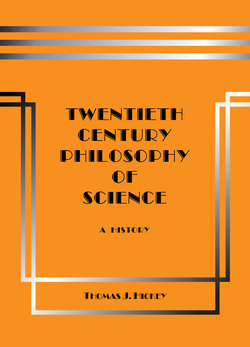Читать книгу Twentieth-Century Philosophy of Science: A History (Third Edition) - Thomas J. Hickey - Страница 26
На сайте Литреса книга снята с продажи.
Thesis III: Ontological relativity.
ОглавлениеIn his discussions about Einstein’s special theory of relativity in Physics and Philosophy and in Across the Frontiers Heisenberg describes the “decisive step” in the development of special relativity. That step was Einstein’s rejection of 1902 Nobel-laureate Hendrik Lorentz’s distinction between “apparent time” and “actual time” in the Lorentz-Fitzgerald contraction. Lorentz took the Newtonian concepts to describe real space and time. In his relativity theory Einstein took Lorentz’s “apparent time” as physically real time, while altogether rejecting the Newtonian concept of absolute time as real time. In other words the “decisive step” in Einstein’s special theory of relativity consisted of Einstein’s taking the relativity theory realistically, thus letting his relativity theory characterize the physically real, i.e., physical ontology.
Also in “History of Quantum Theory” in his Physics and Philosophy Heisenberg describes his imitation of Einstein in his discovery experience for quantum theory. There he states that his thinking about the uncertainty relations consisted of turning around a question. Instead of asking himself how one can express in the Newtonian mathematical scheme a given experimental situation, he asked whether only such experimental situations can arise in nature as can be described in the formalism of his quantum mechanics. The new question is an ontological question with the answer supplied by his quantum theory.
Again in “Remarks on the Origin of the Relations of Uncertainty” in The Uncertainty Principle and Foundations of Quantum Mechanics Heisenberg explicitly states that a Newtonian path of the electron in the cloud chamber does not exist. And still again in “The Development of the Interpretation of the Quantum Theory” in 1945 Nobel-laureate Wolfgang Pauli’s Niels Bohr and the Development of Physics, Heisenberg says that he inverted the question of how to pass from an experimentally given situation to its mathematical representation. There he concludes that only those states that can be represented as vectors in Hilbert space can exist in nature and be realized experimentally. And he immediately adds that this conclusion has its prototype in Einstein’s special theory of relativity, when Einstein had removed the difficulties of electrodynamics by saying that the apparent time of the Lorentz transformation is real time.
Like Heisenberg in 1926, the contemporary pragmatist philosophers let the scientist rather than the philosopher decide ontological questions. And the scientist decides on the basis of empirical adequacy demonstrated in his empirically tested explanations. Many years later in his Ontological Relativity Quine called this thesis “ontological relativity”, as it is known today.
Ontological relativity did not begin with Heisenberg much less with Quine. Copernicus and Galileo practiced it when they both interpreted heliocentrism realistically thus accepting the ontology it describes – to the fateful chagrin of Pope Urban VIII. Heisenberg’s Copenhagen interpretation still prevails in physics today. But should future superior test designs and experiments result in falsification of his Copenhagen interpretation, then physicists’ practice of ontological relativity would make a newer empirically more adequate theory define the prevailing ontology in future microphysics.
The contemporary pragmatist concepts of the four functional topics are summarized as follows:
